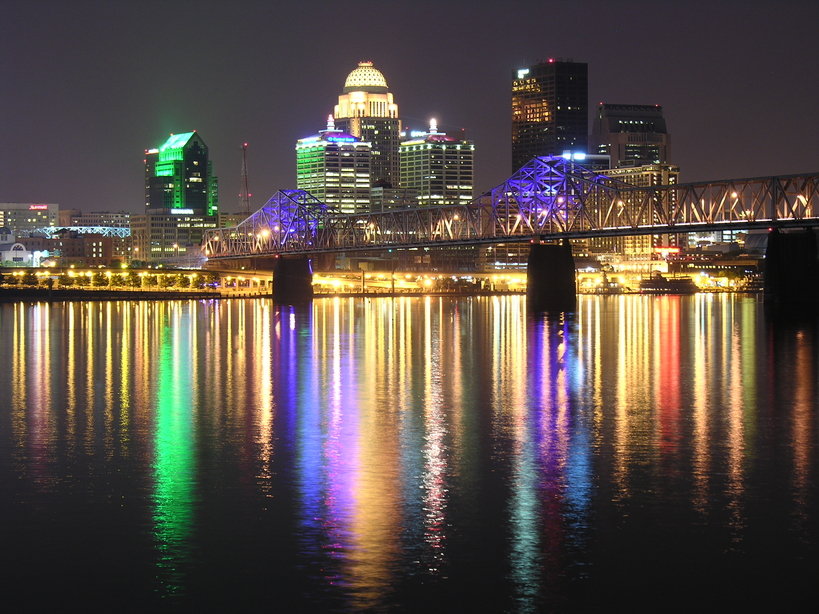Blue Highways: Louisville, Kentucky
Click on the Thumbnail for MapUnfolding the Map
Crossing the Ohio River and whipping around Louisville, we drive with William Least-Heat Moon into the bourbon and horse country of Kentucky. Maybe we'll order a mint julep and sit out on the porch, or maybe we'll just drive onward. Check out the map by clicking on the thumbnail.
Book Quote
"I took the nearest Ohio River bridge at Louisville and whipped around the city..."
Blue Highways: Part 1, Chapter 5
Louisville, Kentucky
I've never been to Louisville, though that's no surprise since there are a lot of places that I've never been. I don't know much about Louisville except for the Kentucky Derby, the Louisville Cardinals basketball team (especially in their heyday when they were one of the top seeds I loved to hate in the NCAA Tournament), and the Louisville Slugger bat.
My connection to Louisville got a lot closer recently when one of my friends, Patrick, got married to a law school colleague, Jillian, just after both finished their law degrees at LSU. After a short stint in Lexington, Kentucky, where Jillian is from, they moved to Louisville where Patrick is employed in a law firm. Their wedding was an interesting mix of New Orleans, where I met Patrick and which is a city that both of them love, and Kentucky. In other words, food served at the wedding had a distinct New Orleans flair, but the drinks and the overall vibe were all Kentucky.
(An aside here. I gave the best man speech at Patrick's wedding, where I called him a true hero. Patrick was a New Orleans city employee who was assigned to the Superdome during Katrina, and endured all the hardships and horrors of being there until he was evacuated with other residents to Houston. As far as I'm concerned, any person who endured the Superdome, from whatever walk of life, is a hero, but Patrick had responsibilities and he took them seriously. He helped the sick and wounded, he helped find food and medicine, and he helped evacuate people. He had to make decisions that might mean life or death, and he often deprived himself to help others. He suffered from, and for all I know still suffers from, post-traumatic stress disorder due to his experiences there. Such experiences might jade any person, but Patrick still has one of the most generous hearts that I know. I will always admire him. Louisville, you got a good man.)
One interesting pre-wedding activity was a visit to the Woodford Reserve distillery in near Lexington, a subsidiary of the Brown-Forman Corporation. I had never appreciated whiskey that much. My father was an inveterate drinker, and his favorite was Early Times whiskey. I was surprised to find that Early Times is made by the Brown-Forman Corporation, which is headquartered in Louisville, and is the official whiskey for the Kentucky Derby Mint Julep. I just remember it not tasting all that great - though I probably haven't sipped any since I was a teenager - and it is full of bad memories associated with my father's alcoholism. Years after my father died, my mother or my sister would still occasionally come across a half-full Early Times bottle that he had stashed somewhere out in the barn or in the back of a closet.
However, the visit to the Woodford Distillery made me appreciate Kentucky bourbon. I had been a fan of Irish whiskey after my wife turned me on to it. I remember, early in our dating, when I ordered a Scotch and soda. "What are you drinking Scotch for?" she asked dismissively. After she turned me on to the Irish, I really never went back, though I am now developing a taste for the occasional Scotch thanks to some friends who like it. But I never thought American liquor could be that good. But Woodford changed that. I liked its taste, especially straight. My wife, who always bragged that Irish whiskey was triple distilled, unlike the demon Scotch, was surprised to learn that much of the craft of making bourbon at Woodford was derived from Irish techniques and that Woodford bourbon is also triple distilled. I ended up drinking a lot of it that weekend, and we bought some that comes out on special occasions. We used it to toast the memory of a recent friend that died, and who would have appreciated the gesture.
I'm not sure what my point is here, other than that a corporation in Louisville may be connected with a whiskey that brings up bad memories of my father, but now a bourbon by the same company is also connected with great memories of the beginning of a lasting love and marriage, and Louisville is now the home of a good friend and his lovely new wife. My antipathy toward the Louisville Cardinals has diminished over time, and I always like catching the "most exciting two minutes in sports" when the horses take the track at Churchill Downs for the Run for the Roses. So, Louisville, you've come a long way in my estimation, and you may see me traversing your streets and sampling your wares sometime.
If you want to know more about Louisville
Consuming Louisville (blog)
I Heart My City (Louisville) by Michelle Ray
Leo Weekly (alternative newspaper)
Louisville.com
Louisville Courier-Journal (newspaper)
Louisville Hot Bytes (blog)
Louisville Travel Site
Metromix Louisville
'Ville Voice Eats (blog)
Wikipedia: Kentucky Derby
Wikipedia: Louisville
Next up: La Grange, Kentucky




 Thursday, June 10, 2010 at 1:56PM
Thursday, June 10, 2010 at 1:56PM



